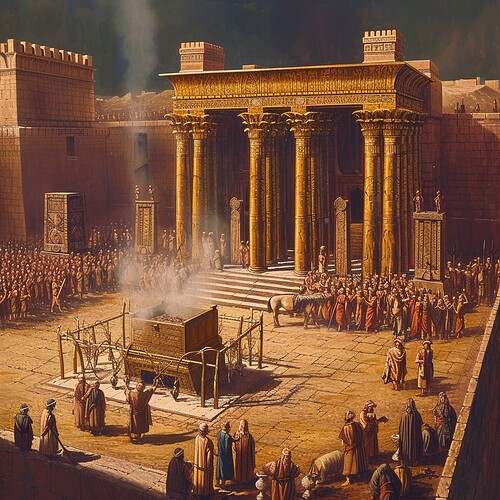![]() February 25: Exodus 38 - Stepping Closer to the Glory of God
February 25: Exodus 38 - Stepping Closer to the Glory of God
![]() Introduction:
Introduction:
As we delve into the Exodus 38, we’re invited to witness the meticulous details involved in the creation of the sacred Tabernacle. Through the diligence of Bezalel, the sacredness of the altar, and the meticulous creation of the courtyard, we continue to see God’s divine presence guiding His people.
![]() Bezalel’s Faithful Craftsmanship:
Bezalel’s Faithful Craftsmanship:
Bezalel, filled with the Spirit of God, crafts the bronze altar, basin, and the courtyard. His diligent craftsmanship reframes work as a form of worship.
![]() Key Verse: Exodus 38:22 “Bezalel son of Uri, the son of Hur, of the tribe of Judah, made everything the Lord commanded Moses.”
Key Verse: Exodus 38:22 “Bezalel son of Uri, the son of Hur, of the tribe of Judah, made everything the Lord commanded Moses.”
![]() The Altar and Basin:
The Altar and Basin:
These items serve an essential purpose for ritual cleansing before approaching God. We’re reminded of the importance of spiritual purity.
![]() Key Verse: Exodus 38:8 “They made the bronze basin and its bronze stand from the mirrors of the women who served at the entrance to the tent of meeting.”
Key Verse: Exodus 38:8 “They made the bronze basin and its bronze stand from the mirrors of the women who served at the entrance to the tent of meeting.”
![]() Key Themes and Reflections:
Key Themes and Reflections:
- The sacredness of work: Bezalel crafts with diligence and care, highlighting our own call to view our work as a form of worship.
- The importance of spiritual purity: The bronze basin calls for ritual cleansing, urging us to continually cleanse our hearts before God.
![]() Today’s Application:
Today’s Application:
Consider how you can bring worship into your everyday tasks. Perhaps it is through dedicating your efforts to God, treating others with kindness, or striving for excellence. Also, let’s strive for spiritual cleansing through prayer, repentance, and the pursuit of holiness.
![]() Hidden Gem:
Hidden Gem:
Did you notice? The bronze comes from the mirrors of serving women! This reflects the essential contribution of women in the spiritual life of Israel.
![]() Reflective Q&A:
Reflective Q&A:
![]() How does Bezalel’s craftsmanship inspire us today?
How does Bezalel’s craftsmanship inspire us today?
A: It encourages us to bring diligence, creativity, and reverence into our work as an act of worship too.
![]() How can we apply the concept of “spiritual cleansing” in our modern life?
How can we apply the concept of “spiritual cleansing” in our modern life?
A: We can start by seeking repentance, forgiving others, practicing humility, and pursuing personal growth rooted in God’s word.
![]() Join the Discussion:
Join the Discussion:
We encourage you to share how you see your work as an act of worship, and how you seek spiritual cleansing in your life!
![]() See You Tomorrow in Exodus 39, 40:
See You Tomorrow in Exodus 39, 40:
We’ll witness the completion of the Tabernacle - a visual representation of God’s dwelling place among His people. Every thread, every artifact, serves a divine purpose you wouldn’t want to miss!
